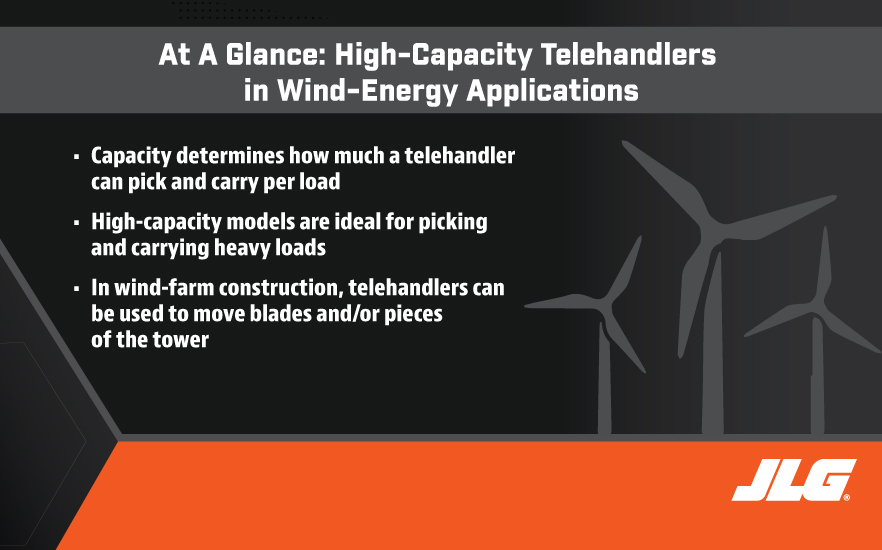Working at height is part of the job for wind-energy technicians, who spend much of their workday suspended hundreds of feet above the ground; equally important is lifting and placing materials during the construction of the wind turbine structures.
For decades, JLG has designed and developed equipment dedicated to helping its customers enhance worksite productivity and safety for a variety of industries, including, fairly recently, the wind-energy industry.
Particularly for the wind industry, JLG offers its high-capacity telehandler line, which includes its JLG® 1644, 1732 and 2733 models, for picking and carrying heavy loads around a work site.

Industry Applications
In general, telehandlers are used for lifting and placing materials. On a general construction site, the primary spec people are interested in a telehandler’s reach so they know how high they can lift and place a load.
In the wind sector, height is also important — but, capacity is the primary spec as it determines how much a telehandler can pick and carry per load. JLG’s high-capacity telehandler line, which complements the company’s traditional telehandler line, is used in industries, such as wind, where operators frequently move very heavy objects.
For example, in wind-farm construction, if the operator wants to move one of the blades, or a piece of the tower, that’s where a high-capacity telehandler would be used. It might come on a truck. The telehandler then unloads it before moving it to the area where it’s needed.
Even though JLG began focusing on the wind industry in 2017 with the introduction of its high-capacity telehandler line, the company’s expertise with other industries laid the groundwork for success.
JLG’s high-capacity telehandler line was designed for the wind-energy and related markets, including oil and gas. You’re going to find the company’s traditional telehandlers on just about every job site where materials are lifted and placed. There was a market in wind for high-capacity telehandlers specifically. It’s a niche market for the brand.
And, you’ll find JLG MEWPs (mobile elevating work platforms), articulating and telescoping boom lifts; electric- and hydraulic-drive scissor lifts; portable personal vertical lifts; low-level access solutions; and telehandlers, in that market as well, doing maintenance on existing structures.
More Than Wind
Although the wind industry has a history of its technicians working at height, JLG’s focus is not dedicated solely to the wind. Industries like oil and gas, steel erection, industrial construction and mining also present unique challenges to equipment operators. With a wide range of specialized attachments, JLG’s high-capacity telehandlers can adapt to demanding job sites and replace other traditional machines. Plus, their ability to handle heavy, bulky loads makes them ideal for performing maintenance on other machines in the equipment fleet.
As the company continues to offer equipment solutions for working at height across the globe, it will continue to improve upon its product line in conjunction with the needs of these marketplaces.
And as far as the wind industry goes, JLG will keep working closely with that constantly growing market, keeping an eye on the wind industry to identify unmet needs and then innovating to evolve the brand’s equipment offerings to deliver solutions that meet those needs.
To learn more about JLG’s high-capacity telehandlers, click here.
Do you want to stay up-to-date with industry news and issues similar to this? Make sure you subscribe below to receive monthly updates from #DirectAccess with newly posted content so you never miss important information.